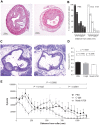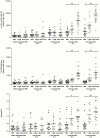Passive immunization with hypochlorite-oxLDL specific antibodies reduces plaque volume in LDL receptor-deficient mice
- PMID: 23874490
- PMCID: PMC3713002
- DOI: 10.1371/journal.pone.0068039
Passive immunization with hypochlorite-oxLDL specific antibodies reduces plaque volume in LDL receptor-deficient mice
Abstract
Aims: New strategies to overcome complications of cardiovascular diseases are needed. Since it has been demonstrated that atherosclerosis is an inflammatory disease, modulation of the immune system may be a promising approach. Previously, it was suggested that antibodies may confer protective effects on the development of atherosclerosis. In this study, we hypothesised that passive immunization with anti-oxLDL IgM antibodies specific for hypochlorite (HOCl) may be athero-protective in mice.
Methods and results: Monoclonal mouse IgM antibodies were produced and the antibody with specificity for hypochlorite-oxLDL (HOCl-oxLDL) (Moab A7S8) was selected. VH sequence determination revealed that Moab A7S8 is a natural IgM antibody. Atherosclerosis in LDLr(-/-) mice was induced by a perivascular collar placement around the right carotid artery in combination with feeding a high-fat diet. Subsequently, the mice were treated every six days with 500 µg Moab A7S8, non-relevant IgM or with PBS and the carotid arteries and aortic roots were studied for atherosclerosis. Passive immunization with this Moab A7S8 resulted in a significant reduced plaque volume formation in LDLr(-/-) mice when compared with PBS treatment (P = 0.002 and P = 0.035). Cholesterol levels decreased by 20% when mice were treated with Moab A7S8 compared to PBS. Furthermore, anti-oxLDL specific IgM and IgG antibody production increased significantly in the Moab A7S8 treated mice in comparison with PBS treated mice.
Conclusion: Our data show that passive immunization with a natural IgM antibody, directed to HOCl-oxLDL, can reduce atherosclerotic plaque development. We postulate that specific antibody therapy may be developed for use in human cardiovascular diseases.
Conflict of interest statement
Figures








References
-
- Hansson GK, Libby P (2006) The immune response in atherosclerosis: a double-edged sword. Nat Rev Immunol 6: 508–519. - PubMed
-
- Chyu KY, Nilsson J, Shah PK (2007) Active and passive immunization for atherosclerosis. Curr Opin Mol Ther 9: 176–182. - PubMed
-
- van Leeuwen M, Damoiseaux J, Duijvestijn A, Tervaert JW (2009) The therapeutic potential of targeting B cells and anti-oxLDL antibodies in atherosclerosis. Autoimmun Rev 9: 53–57. - PubMed
-
- Faria-Neto JR, Chyu KY, Li X, Dimayuga PC, Ferreira C, et al. (2006) Passive immunization with monoclonal IgM antibodies against phosphorylcholine reduces accelerated vein graft atherosclerosis in apolipoprotein E-null mice. Atherosclerosis 189: 83–90. - PubMed
Publication types
MeSH terms
Substances
LinkOut - more resources
Full Text Sources
Other Literature Sources
Molecular Biology Databases

